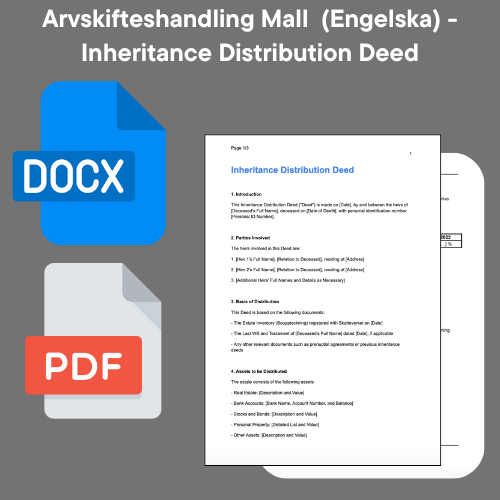What should an inheritance deed contain?
Share
When a person dies and leaves behind assets, the need for probate arises. Probate is the process by which the deceased's estate is divided between the heirs according to the will or order of succession. One of the most important documents in this process is the deed of inheritance, which formally establishes how the assets are to be distributed. In this article, we go through what an inheritance deed should contain in order to be legally correct and avoid future disputes.
Table of contents
- Introduction to the inheritance deed
- Basic information in the inheritance document
- Detailed distribution of assets
- Debts and financial obligations
- Signatures and witnessing
- Form requirements and legal aspects
- Conclusion: The Importance of a Correct Probate Deed
- Use of document templates for inheritance documents
Introduction to the inheritance deed
A probate deed is a formal document drawn up when a deceased person's assets are to be divided between the heirs. It is a binding agreement that must be carefully drafted to ensure that all parties agree and that the distribution takes place according to the requirements of the law. This document plays a central role in avoiding conflicts between the heirs and ensuring that the succession takes place in a fair and correct manner.
Basic information in the inheritance document
For an inheritance deed to be valid and legally sustainable, it must contain certain basic information. Listed below are the most important elements that should be included:
Personal data
- Full name, social security number and address of the deceased.
- Full name, social security number and address for all heirs and legatees.
Information about the estate
- Description of all assets that belonged to the deceased, including real estate, bank accounts, securities, vehicles and other valuables.
- Statement of the deceased's debts and other financial obligations.
- Any benefits or special distributions specified in the will.
Testament
- If a will exists, a copy of it must be attached to the probate document. It is important that the will clearly sets out the wishes of the deceased regarding the distribution of the assets.
- If the will contains special conditions or reservations, these should also be clearly stated in the inheritance document.
Detailed distribution of assets
The inheritance deed must also specify how each individual asset is to be distributed between the heirs. Here it is important to be as detailed as possible to avoid future misunderstandings or disputes. The assets should be divided and valued in a way that all heirs agree on.
Properties
If the deceased owned real estate, their value must be determined and the distribution of the real estate among the heirs indicated. This may mean that properties are sold and that the proceeds of the sale are shared, or that one or more heirs take over ownership and compensate the other heirs financially.
Bank assets and securities
Bank accounts, shares and other securities must be reported and distributed according to the will or agreement between the heirs. Here, it is important to take into account any taxes and fees that may be added upon transfer or sale.
Other assets
Assets such as jewellery, works of art, vehicles and other valuables must also be specified in the inheritance document. These objects can either be physically divided between the heirs or sold and the value divided.
Debts and financial obligations
An important part of the inheritance document is to report the deceased's debts and other financial obligations. These must be dealt with before the assets can be distributed among the heirs.
Liabilities
It is necessary to identify and account for all debts that the deceased had at the time of his death. This includes any mortgages, personal loans, credit card debt and other financial obligations.
Payment of debts
The probate deed must contain a plan for how these debts are to be paid, which usually takes place through the sale of assets or through the heirs jointly paying the debts.
Signatures and witnessing
In order for the deed of inheritance to be legally binding, it must be signed by all the heirs. It is also recommended that the deed be witnessed by two people who are independent of the heirs.
Signatures
All heirs must sign the probate deed to confirm that they agree to the content and distribution of the assets.
Witnessing
Two witnesses should be present at the signing and also sign the document to confirm its validity. The witnesses should be over 18 years of age and not be related to the heirs.
Form requirements and legal aspects
It is important that the deed of inheritance complies with the formal requirements set by Swedish law in order to be legally valid. A formal error in the deed can lead to the inheritance not being approved, which can result in delays and potential disputes.
Form requirements
The action must be written and clearly designed. It is important to use a template that is adapted to current laws and regulations to ensure that all requirements are met.
Legal advice
While it is possible to draw up a probate deed on your own, it may be wise to hire legal help to ensure everything goes right. A lawyer can help interpret the will, value the assets and ensure that the deed complies with all legal requirements.
Conclusion: The Importance of a Correct Probate Deed
Drawing up a correct inheritance document is crucial to ensure that the inheritance is distributed fairly and in accordance with the wishes of the deceased and Swedish legislation. By being careful in drafting the deed and ensuring that all formal requirements are met, the heirs can avoid future conflicts and ensure that the inheritance is distributed in a way that everyone agrees on.
Use of document templates for inheritance documents
For those who want to ensure that their inheritance deed is correctly drafted, it may be a good idea to use a document template. Our document templates are carefully designed to meet all legal requirements and help the heirs carry out the succession in a smooth and legally secure manner.
Our templates contain all the necessary elements to be included in an inheritance deed, and are easy to adapt to your specific needs. By using a template, you save time and ensure that all formal requirements are met, minimizing the risk of future problems.
By carefully following this guide and using a well-designed document template, you can ensure that your inheritance goes as smoothly as possible and that all parties involved are satisfied with the outcome.


